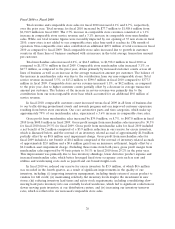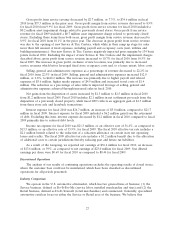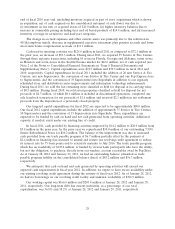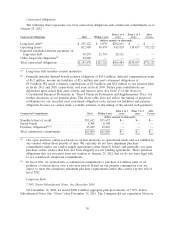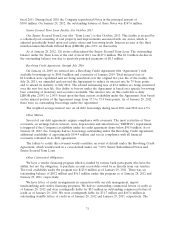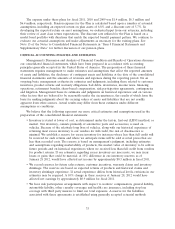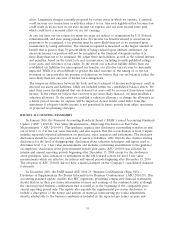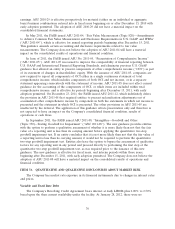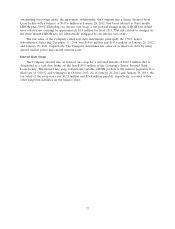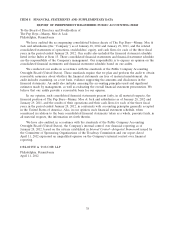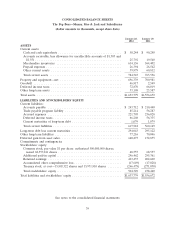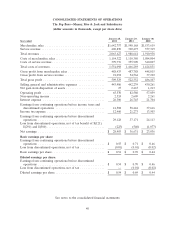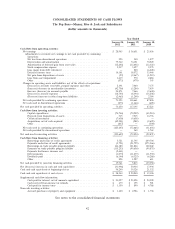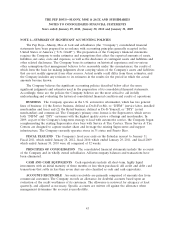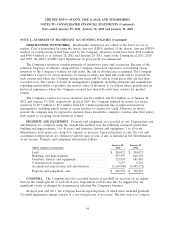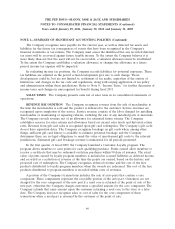Pep Boys 2011 Annual Report Download - page 80
Download and view the complete annual report
Please find page 80 of the 2011 Pep Boys annual report below. You can navigate through the pages in the report by either clicking on the pages listed below, or by using the keyword search tool below to find specific information within the annual report.earnings. ASU 2010-29 is effective prospectively for material (either on an individual or aggregate
basis) business combinations entered into in fiscal years beginning on or after December 15, 2010 with
early adoption permitted. The adoption of ASU 2010-29 did not have a material impact on the
consolidated financial statements.
In May 2011, the FASB issued ASU 2011-04, ‘‘Fair Value Measurement (Topic 820)—Amendments
to Achieve Common Fair Value Measurement and Disclosure Requirements in U.S. GAAP and IFRSs’’
(‘‘ASU 2011-04’’), which is effective for annual reporting periods beginning after December 15, 2011.
This guidance amends certain accounting and disclosure requirements related to fair value
measurements. The Company does not believe the adoption of ASU 2011-04 will have a material
impact on the consolidated results of operations and financial condition.
In June of 2011, the FASB issued ASU No. 2011-05, ‘‘Presentation of Comprehensive Income’’
(‘‘ASU 2011-05’’). ASU 2011-05 was issued to improve the comparability of financial reporting between
U.S. GAAP and International Financial Reporting Standards, and eliminates previous U.S. GAAP
guidance that allowed an entity to present components of other comprehensive income (‘‘OCI’’) as part
of its statement of changes in shareholders’ equity. With the issuance of ASU 2011-05, companies are
now required to report all components of OCI either in a single continuous statement of total
comprehensive income, which includes components of both OCI and net income, or in a separate
statement appearing consecutively with the statement of income. ASU 2011-05 does not affect current
guidance for the accounting of the components of OCI, or which items are included within total
comprehensive income, and is effective for periods beginning after December 15, 2011, with early
adoption permitted. On December 23, 2011, the FASB issued ASU 2011-12, which indefinitely defers
the provision in ASU 2011-05 that required entities to present reclassification adjustments out of
accumulated other comprehensive income by component in both the statements in which net income is
presented and the statement in which OCI is presented. The other provisions in ASU 2011-05 are
unaffected by the deferral. The application of this guidance affects presentation only and therefore is
not expected to have an impact on the Company’s consolidated financial condition, results of
operations or cash flows.
In September 2011, the FASB issued ASU 2011-08, ‘‘Intangibles—Goodwill and Other
(Topic 350)—Testing Goodwill for Impairment’’ (‘‘ASU 2011-08’’). The new guidance provides entities
with the option to perform a qualitative assessment of whether it is more likely than not that the fair
value of a reporting unit is less than its carrying amount before applying the quantitative two-step
goodwill impairment test. If an entity concludes that it is not more likely than not that the fair value of
a reporting unit is less than its carrying amount, it would not be required to perform the quantitative
two-step goodwill impairment test. Entities also have the option to bypass the assessment of qualitative
factors for any reporting unit in any period and proceed directly to performing the first step of the
quantitative two-step goodwill impairment test, as was required prior to the issuance of this new
guidance. The new guidance is effective for fiscal years, and interim periods within those years,
beginning after December 15, 2011, with early adoption permitted. The Company does not believe the
adoption of ASU 2011-08 will have a material impact on the consolidated results of operations and
financial condition.
ITEM 7A QUANTITATIVE AND QUALITATIVE DISCLOSURES ABOUT MARKET RISK
The Company has market rate exposure in its financial instruments due to changes in interest rates
and prices.
Variable and Fixed Rate Debt
The Company’s Revolving Credit Agreement bears interest at daily LIBOR plus 2.00% to 2.50%
based upon the then current availability under the facility. At January 28, 2012, there were no
36


